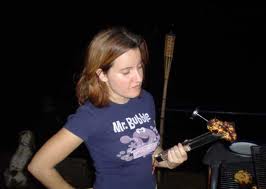Chapman still owes me food thermometers.
 He says he’ll send them, he says he’ll come to Australia, but nothing.
He says he’ll send them, he says he’ll come to Australia, but nothing.
And he’s supposed to be the co-author on my next book.
It’s so hard to get good help.
But I’ve recruited the best of the past and we’ll get something done if my brain hangs together.
Barbara Gordon of At Right writes that you can’t tell if a food is safely cooked by sight, smell or even taste. A food thermometer is the only way to ensure food is cooked to the proper temperature and harmful bacteria are eliminated.
(Tell that to the British Food Safety Agency and their piping hot directive).
A food thermometer is not needed just for meat and poultry. A safe minimum internal temperature must be reached to avoid food poisoning in all cooked foods. The “danger zone” for perishable foods is between 40° and 140° Fahrenheit. Perishable foods are no longer safe to eat if they have been in this danger zone for more than two hours (one hour in 90° Fahrenheit or above). A food thermometer also is needed after food is cooked to ensure the temperature doesn’t fall into the danger zone. This is especially important for buffet and potluck-style gatherings.
